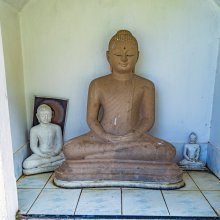Miya, Mīya, Mīyā, Miyā: 4 definitions
Introduction:
Miya means something in Hinduism, Sanskrit, the history of ancient India, biology, Tamil. If you want to know the exact meaning, history, etymology or English translation of this term then check out the descriptions on this page. Add your comment or reference to a book if you want to contribute to this summary article.
Images (photo gallery)
In Hinduism
Vyakarana (Sanskrit grammar)
Source: Wikisource: A dictionary of Sanskrit grammarMīya (मीय).—tad. affix मीय (mīya) along with म (ma) (मण् (maṇ)) applied to the word मध्य (madhya) in the sense of a case-affix (locative case-affix) e.g. मध्यमीय (madhyamīya) ; cf मण्मीयौ च प्रत्ययौ वक्तव्यौ (maṇmīyau ca pratyayau vaktavyau) Kaas. on P. IV.3.60.

Vyakarana (व्याकरण, vyākaraṇa) refers to Sanskrit grammar and represents one of the six additional sciences (vedanga) to be studied along with the Vedas. Vyakarana concerns itself with the rules of Sanskrit grammar and linguistic analysis in order to establish the correct context of words and sentences.
Purana and Itihasa (epic history)
Source: JatLand: List of Mahabharata people and placesMīyā (मीया) is a name mentioned in the Mahābhārata (cf. II.48.4 II.48.4) and represents one of the many proper names used for people and places. Note: The Mahābhārata (mentioning Mīyā) is a Sanskrit epic poem consisting of 100,000 ślokas (metrical verses) and is over 2000 years old.

The Purana (पुराण, purāṇas) refers to Sanskrit literature preserving ancient India’s vast cultural history, including historical legends, religious ceremonies, various arts and sciences. The eighteen mahapuranas total over 400,000 shlokas (metrical couplets) and date to at least several centuries BCE.
India history and geography
Source: Shodhganga: A translation of Jhaverchand Meghanis non translated folk talesMiya refers to “A Muslim gentleman”.—It is defined in the glossary attached to the study dealing with Gujarat Folk tales composed by Gujarati poet Jhaverchand Meghani (1896-1947)

The history of India traces the identification of countries, villages, towns and other regions of India, as well as mythology, zoology, royal dynasties, rulers, tribes, local festivities and traditions and regional languages. Ancient India enjoyed religious freedom and encourages the path of Dharma, a concept common to Buddhism, Hinduism, and Jainism.
Biology (plants and animals)
Source: Google Books: CRC World Dictionary (Regional names)Miya in Peru is the name of a plant defined with Tripodanthus acutifolius in various botanical sources. This page contains potential references in Ayurveda, modern medicine, and other folk traditions or local practices It has the synonym Phrygilanthus ligustrinus (Willd. ex Roem. & Schult.) Eichler (among others).
Example references for further research on medicinal uses or toxicity (see latin names for full list):
· Flora Peruviana (1802)
· Bulletin de la Société Botanique de France (1895)
· Flora Brasiliensis (1868)
· Flora of Ecuador (1986)
· A General History of the Dichlamydeous Plants (1834)
If you are looking for specific details regarding Miya, for example diet and recipes, health benefits, extract dosage, chemical composition, pregnancy safety, side effects, have a look at these references.

This sections includes definitions from the five kingdoms of living things: Animals, Plants, Fungi, Protists and Monera. It will include both the official binomial nomenclature (scientific names usually in Latin) as well as regional spellings and variants.
See also (Relevant definitions)
Starts with: Miya-moe, Miyad, Miyada, Miyako-jima-hana-warabi, Miyaksh, Miyalunkanattar, Miyam, Miyama-shikimi, Miyamana, Miyan, Miyan milla, Miyana, Miyani, Miyatci, Miyati, Miyav, Miyavai, Miyaye.
Ends with (+183): Abbhagamiya, Abbhovagamiya, Abhiramiya, Abhiramiya, Abhiramiya, Addhovamiya, Adhammiya, Agamiya, Aghummiya, Agnisharmiya, Agnishomiya, Agnishtomiya, Ahammiya, Ahigamiya, Ajbhovagamiya, Akamiya, Akshnayastomiya, Akusmiya, Algamiya, Amgumiya.
Full-text: Miya-moe, Kiswenya-cha-miya, Vima, Pramiya, Shakalahoma, Jimita, Mi, Saudharma, Saudharmakalpa, Samadapayati, Ma.
Relevant text
Search found 6 books and stories containing Miya, Mīya, Mīyā, Miyā; (plurals include: Miyas, Mīyas, Mīyās, Miyās). You can also click to the full overview containing English textual excerpts. Below are direct links for the most relevant articles:
List of Mahabharata tribes (by Laxman Burdak)
Complete works of Swami Abhedananda (by Swami Prajnanananda)
Chapter 9 - Shintoism in Japan < [Discourse 7 - Thoughts on Sankhya Buddhism and Vedanta]
List of Mahabharata people and places (by Laxman Burdak)
The Practice Manual of Noble Tārā Kurukullā (by Dharmachakra Translation Committee)
Chapter 7 < [Appendix - Sanskrit Text]
The Monsoon Melody < [January - March 1975]
The Case for Rejection < [November-December 1934]
Folk Tales of Gujarat (and Jhaverchand Meghani) (by Vandana P. Soni)
Chapter 7c - Gigo Mahiyo < [Part 2 - Sorathi Baharvatiya]
